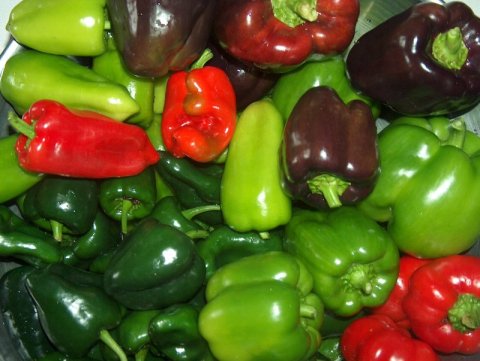Pick of the Peck
August 28, 2011

What to do with the bounty?
Nothing beats homemade roasted hot or sweet peppers which can be added to salads, sauces and soups or turned into various condiments, like Piri Piri sauce.
However, before you start cooking, take care handling hot peppers. The hottest parts of the peppers are the skins, seeds and soft white ribs on the inside of the peppers. You should also rate the hotness of your peppers before handling them.
You can consult Scoville scores, developed in 1912 by American pharmacologist Wilber Scoville, which measures capsaicin levels, or you can rely on a simpler gauge for hotness — reputation.
Common hot pepper varieties are Jalapeno, Habanero and Scotch Bonnets. Much, much hotter varieties than these exist, but frankly they probably shouldn’t be eaten at all. Indeed, malevolent uses are planned for the latest, hottest pepper of them all, the Naga Viper.
Roast peppers in a hot oven, under the broiler or over the open flame of the gas jets on your stove. The best flavor comes from roasting over a wood fire from an outdoor grill or fireplace. Place well-washed whole hot peppers on foil or a metal baking sheet if cooking in the oven or under the broiler. Place peppers directly on the grill rack or use extra long grilling tongs or skewers to hold them over the fire of an outdoor grill, stove or fireplace.
Turn peppers as they blacken on all sides. Avoid rough handling or piercing the softening skins so you don’t lose the juices that have built up inside. Put hot, fully charred peppers into a glass or stainless bowl and cover with foil or a lid to continue steaming and softening the peppers. Avoid standing too near the bowl as the rising steam has oils from the hot peppers that can burn your eyes or nose. Cool peppers thoroughly before handling them.
You can wait up to a couple of days before handling them again – the flavor will only improve! When you do get around to peeling the peppers wear vinyl food handler gloves to protect yourself, especially if handling very hot peppers like Scotch Bonnets or Habanero, and be very sure not to accidentally touch your face in the process. Use small tongs or a paring knife to carefully trim off the burnt parts; slice open the peppers and pull out the stem holding the seeds and rib membranes as best as you can. Retain the steeped juices and some seeds and add them to your prepped peppers. Slice, dice, mash or leave peppers whole for stuffing – whatever the recipe dictates.
Plain roasted peppers keep in the fridge for up to one week or more. They freeze well too. Canning takes a bit more work but is certainly worth it if you’re putting up large quantities. Local blog “Food In Jars” is an excellent resource for canning all kinds of foods.
Culinary historian William Woys Weaver talks about a popular hot pepper vinegar in his book, “Sauerkraut Yankees,” which offers recipes from an 1848 Pennsylvania Dutch cookbook.
Says Weaver: “Among Philadelphians, pepper vinegar was used with the same frequency (and just as sparingly) as horseradish or its closest cousin Tabasco. It was sometimes poured hot over salad greens, added to pickles and sauces, or even sprinkled over scrapple, sausage, and other pork products. It appears to have been one of those hot West Indian things that gained popularity in the United States during the late 18th and 19th centuries but is now gratefully forgotten, retired by the much milder Creole chili sauces, which are now as popular among the Pennsylvania Germans as they are anywhere.”
It’s easy enough to create your own version of this hot pepper vinegar using your freshly made roasted hot peppers. Add a tablespoon of mashed or diced roasted hot peppers to a clean, sterilized glass jar; add one cup boiling white vinegar, apple cider vinegar or rice wine vinegar to the jar. Cool mixture and cap jar with sterilized lid. Keep refrigerated.
Enjoy, sparingly.
References
William Woys Weaver, Sauerkraut Yankees: Pennsylvania Dutch Foods and Foodways, published by Stackpole Books, 2002.
Pepper photo courtesy of free-extras.com images
Anita Mc Kelvey © 2011-2016 The Philadelphia Pepper Project
